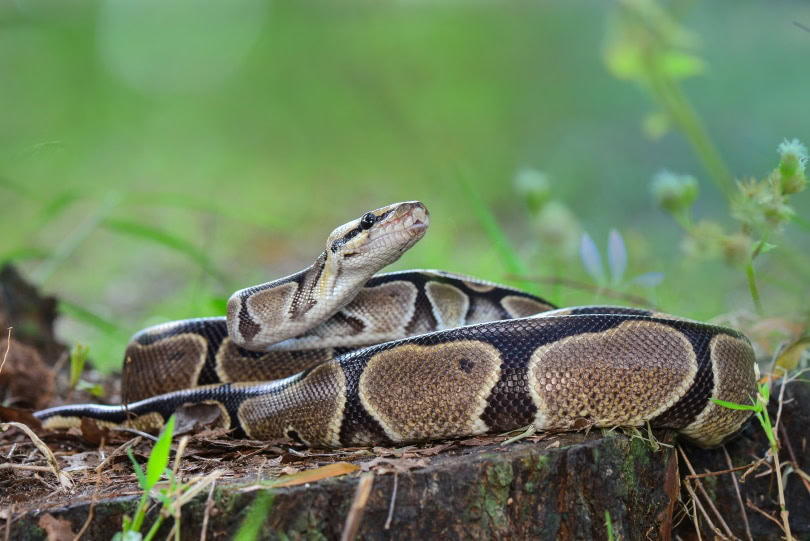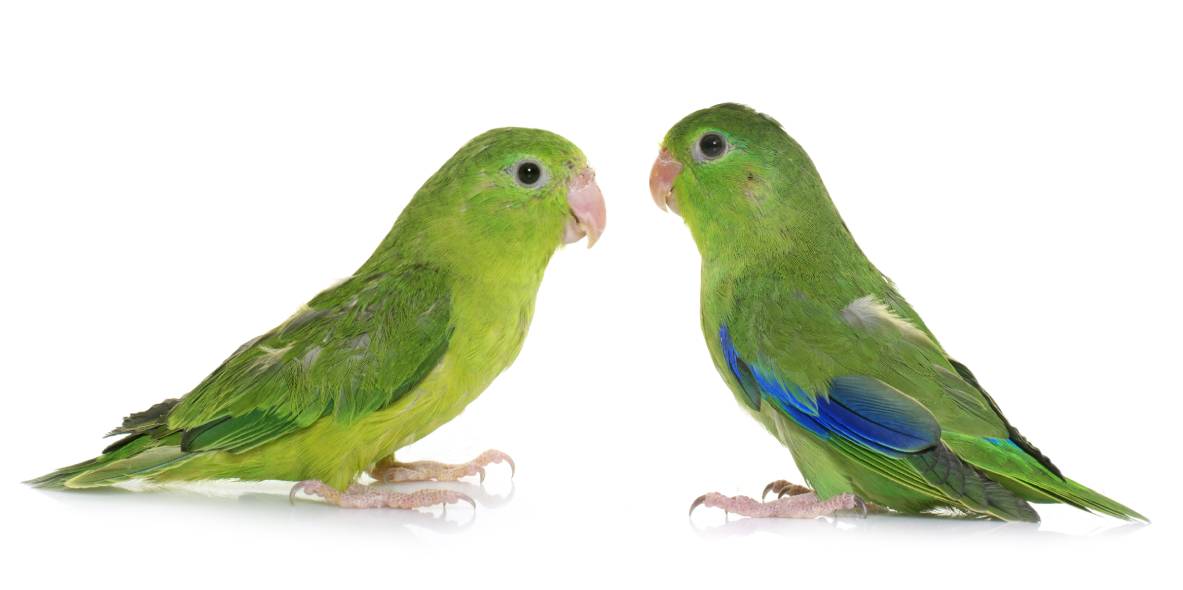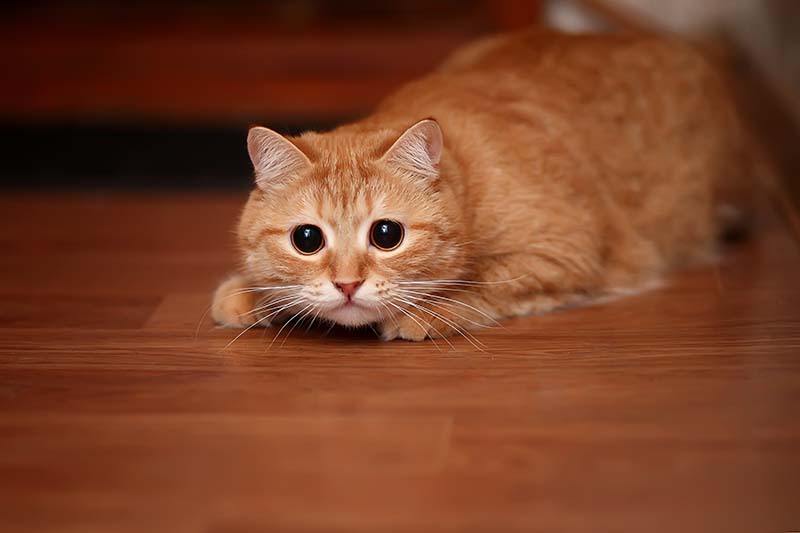VET APPROVED

The information is current and up-to-date in accordance with the latest veterinarian research.
Learn more »Click to Skip Ahead
Whether ball pythons have good vision depends on your definition of “good.” Ball pythons are obviously very different from humans, and thus, they have very different eyesight features. However, that doesn’t necessarily mean that their eyesight is bad – just different.
Fundamentally, a ball python’s vision can be considered good because it enables them to function as efficient nocturnal ambush predators. Comparing their vision to other animals (or us) is counterintuitive; though such comparisons are definitely possible, they don’t answer the question of which species has “better” vision.
Let’s explore a ball python’s vision in greater detail.

The Basics of Vision
All animals with eyes possess a retina within each eye. The retina is a layer at the back of the eyeball which contains unique cells sensitive to light. Being exposed to light triggers nerve impulses from these cells. This impulse then travels to the animal’s brain via the optic nerve, where a visual image can be formed. This concept applies to us as humans as well – in fact, it’s happening as you’re reading this sentence!
The cells that are found in the retina are what sets one species apart from another in terms of visual acuity. These cells are categorized into two: rods and cones.
Rods function in low light environments, and as such, they enable dim-light vision, also known as scotopic vision. The more rods an animal possesses in their retina, the better their vision would be in dim-lit conditions. Rods also help animals perceive movement in their field of vision.
Cones on the other hand are active at higher light levels and allow for what is known as “day time vision”, or more precisely, photopic vision. They also allow an animal to perceive color. Possessing multiple types of cone cells increases the amount of colors an animal may perceive.
Though their fundamental roles are different, rods and cones do in fact work concurrently to help an animal perceive their environment.
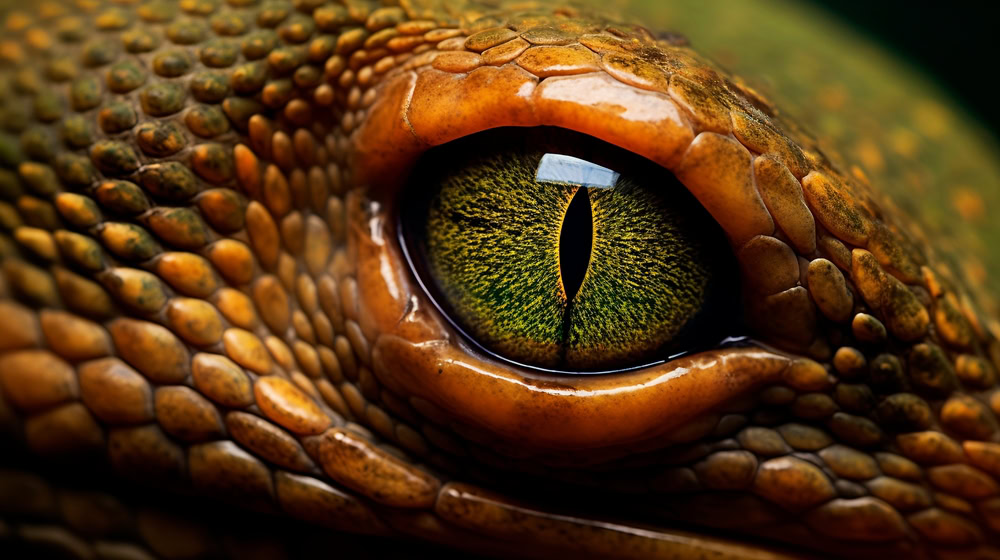
Particularities of Ball Pythons’ Eyesight
A ball python’s vision is very well adapted for night-time vision. The overwhelming majority of the cells in their retinas are rods; they outnumber their cones by a ratio of around 10:1. Their night-time vision rivals that of other nocturnal predators.1
Ball pythons possess two kinds of cone receptors:
- The more abundant cone type helps them perceive a certain amount of color
- A less abundant cone type (found very scarcely) helps them perceive the ultraviolet spectrum
Ball pythons are also able to perceive infrared heat, which helps them perceive their environment at night. However, this isn’t done via their eyes. Instead, they possess specialized “pit organs” located in their face (across their face and mouth) to do this.
These pit organs contain specialized nerves, membranes, and air chambers which allow a snake’s brain to formulate a “heat map” of their surroundings, which is detailed enough to help them distinguish between an animal and the non-living environment around them. In addition, the “heat map” their brain formulates allows them to visualize (or more specifically, perceive) everything around them at a distance of around 10 feet or so.
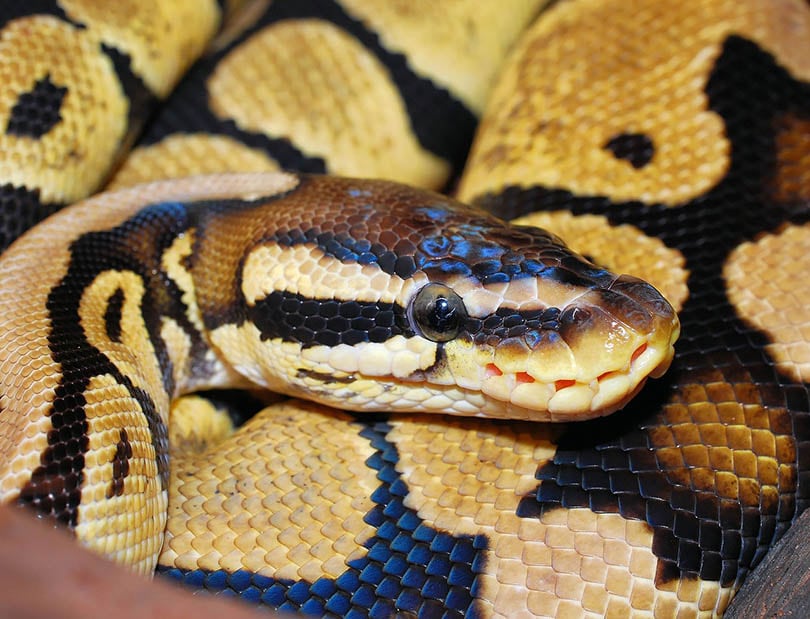
Putting It All To Use!
So how does this all add up in terms of enabling ball pythons to hunt at night? A ball python hunts using both their vision and their ability to perceive infrared light. They will initiate a strike if they have visual stimulation (for instance, they notice a mouse scurrying near them). However, the strike is directed toward the prey using their infrared perception, not their vision!2
In short, a ball python’s vision is extremely well adapted for them to function as nocturnal ambush predators, and works in conjunction with their infrared perception to help them catch prey. Considering how their vision helps them get the job done, it is therefore fair to say that their vision is indeed good (despite being entirely different from ours).
Are Ball Pythons Color Blind?
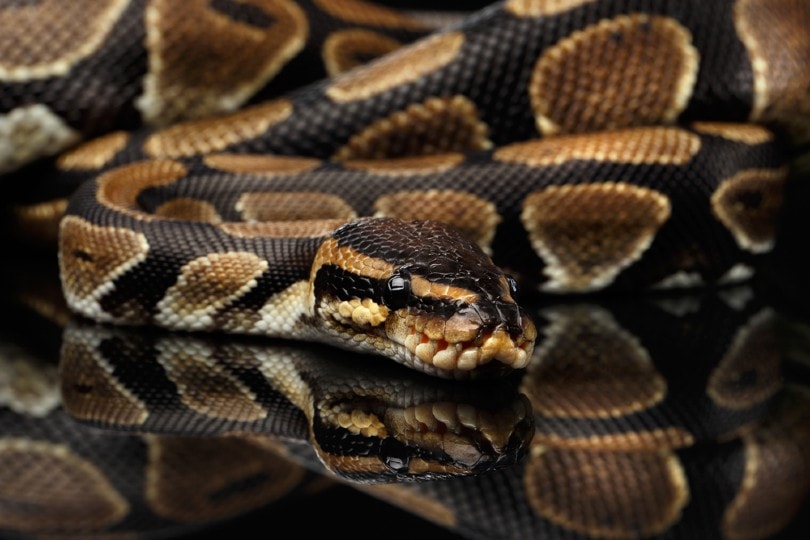
For a long time, we considered all snakes to be colorblind. However, we now know that ball pythons actually have two types of cones. Cones are the part of the eye that detects colors. Therefore, it is likely that ball pythons can see two different colors.
Everything they see is in the shade of one of those colors, black, or white. As an example, we have three different kinds of cones that can detect blue, red, and yellow. All the colors we see are either these three colors, black, or white. Ball pythons will see similarly, minus one of the colors. However, we can’t tell what colors ball pythons see and which ones they don’t. Until we can see through their eyes, we won’t know.
With that said, some experts have suggested that they can see blue and green. It is unclear if they can see yellow as well.
Can Ball Pythons See at Night?
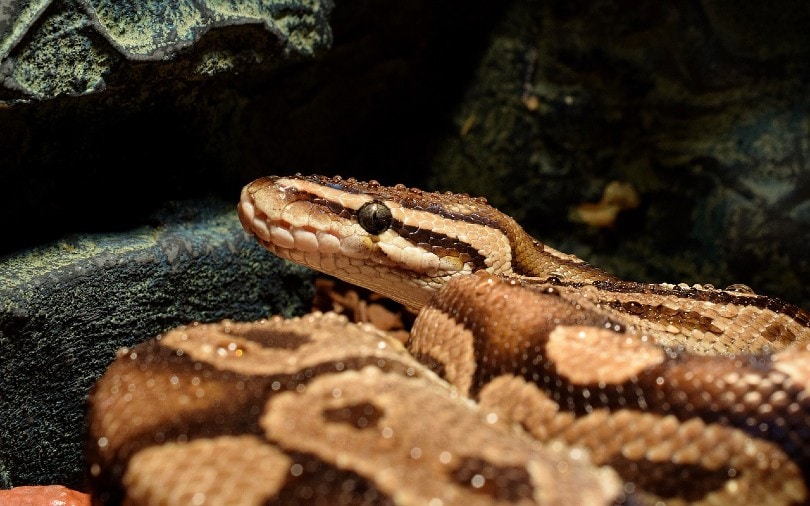
Ball pythons do have “night vision.” However, they likely can’t see as well at night as you’d expect.
It isn’t that they can see at night just as well as they can see during the day. Nighttime does not look like daytime. However, their eyes are built towards detecting movement, not color. They have a high concentration of rods that allows this to occur.
Rods are the parts of the eye that allow you to detect light. This feature doesn’t allow you to detect colors, but it does help with movement. It also helps in low-light conditions since your eye will pick up more of the remaining light.
However, rods don’t help cones work better. The ball python still won’t be able to see colors at night. Everything will be on a greyscale, similarly to how we see at night, only with more distinction.
Furthermore, ball pythons can also detect UV light. This sort of light is completely invisible to the naked human eye. This sort of light is given off by heat, which is obviously still around at night. Therefore, ball pythons can get around at night using UV light as well.
UV light also makes it fairly easy for ball pythons to detect prey items, like mice, which would otherwise be more difficult to find at night.
Are Ball Pythons Sensitive to Light?
Ball pythons are typically nocturnal. In the wild and in captivity, they spend most of their active time at night. However, this doesn’t necessarily mean that they are sensitive to lights.
In most cases, it is recommended that ball pythons in captivity be given lighting. The lighting doesn’t have to be particularly bright, as it is mostly around to help establish a clear day/night cycle. In most normal homes, this can be achieved without providing the reptile with its own light.
Often, the light coming in from the windows and brightening up the house is enough. Do not use night lights, as this may upset their natural rhythm.
However, there is a slight debate when it comes to albino snakes. Albino ball pythons are quite popular and widely available. The trait does not seem to have too many negative effects on the snake, unlike other animals.
With that said, it is possible that albinism can cause a ball python to be more sensitive to light. In these cases, you may want to lessen the lighting around the snake. That doesn’t mean remove it completely – even albino snakes will need some amount of light to determine a wake/sleep cycle.
However, you probably shouldn’t keep your snake near a window or use a reptile light if they have albinism. This may irritate their eyes, though we don’t have any specific scientific information to back this up.
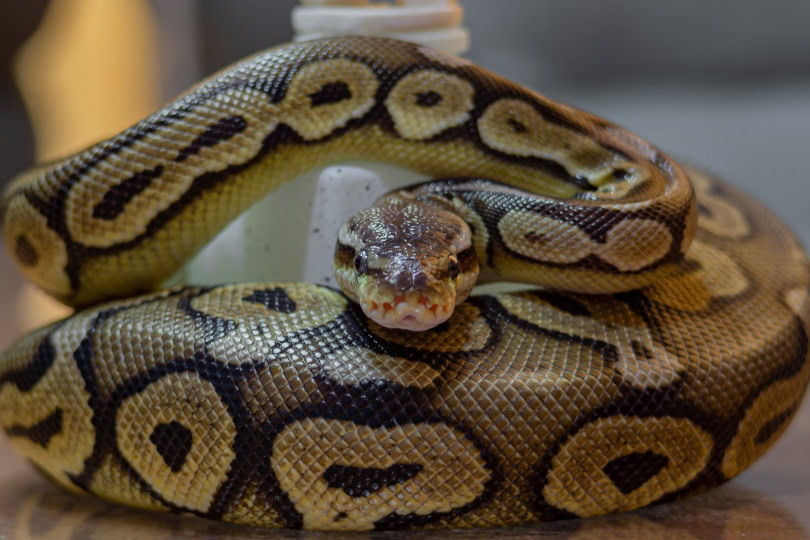
Can Ball Pythons See the Color Red?
Red bulbs are often advertised as “nighttime” bulbs, as it is thought that reptiles cannot see them. However, we don’t actually know if this is the case.
As we previously stated, ball pythons do have two different cones in their eyes, which means that they can see two different colors. However, we don’t know which two colors these actually are. Therefore, they could very well see red. There is no solid way for us to find out for sure.
The theory behind the red light is actually derived from how humans detect light. Red light does not interfere with a human’s sleep cycle in the same way that blue light does. Therefore, it is often recommended to use red or yellow lights at night when you want to see but also sleep.
While red lights won’t disrupt a human’s sleep cycle, we don’t actually know if they work for reptiles. We don’t know how red light disrupts their sleep or whether they can see it. You’ll hear different opinions from different people.
Some keepers are quite certain that their snakes cannot see red light, while others report negative effects. Therefore, we highly recommend avoiding red lights if possible. Ball pythons really don’t need them, after all.
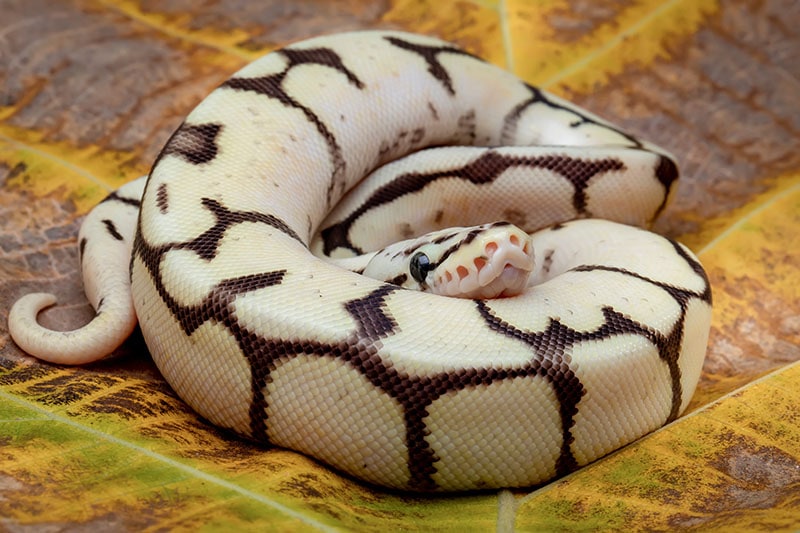

Summary
Ball pythons certainly have different traits for seeing compared to people. They are short-sighted, and their eyes don’t focus quite as well as ours. It is likely that they can only focus on moving objects, like their prey animals.
These snakes can see some colors. They do have two different cones in their eyes; we just don’t know what colors they can see – and there is no way to know unless we figure out a way to ask them.
They can see movement better than we can, thanks to an increase in rods. These rods also help them see better at night, though they still can’t see colors at night.
Like most snakes, ball pythons can sense ultraviolet light, which helps them get around at night as well. This sense helps them locate prey animals.
If you ask a ball python to spot something colorful in the distance, they won’t be able to do it as well as a human. However, they can see things that we can’t see. Therefore, it isn’t necessarily that they have bad vision, just that it is different from ours.
Featured Image Credit: DWI YULIANTO, Shutterstock
